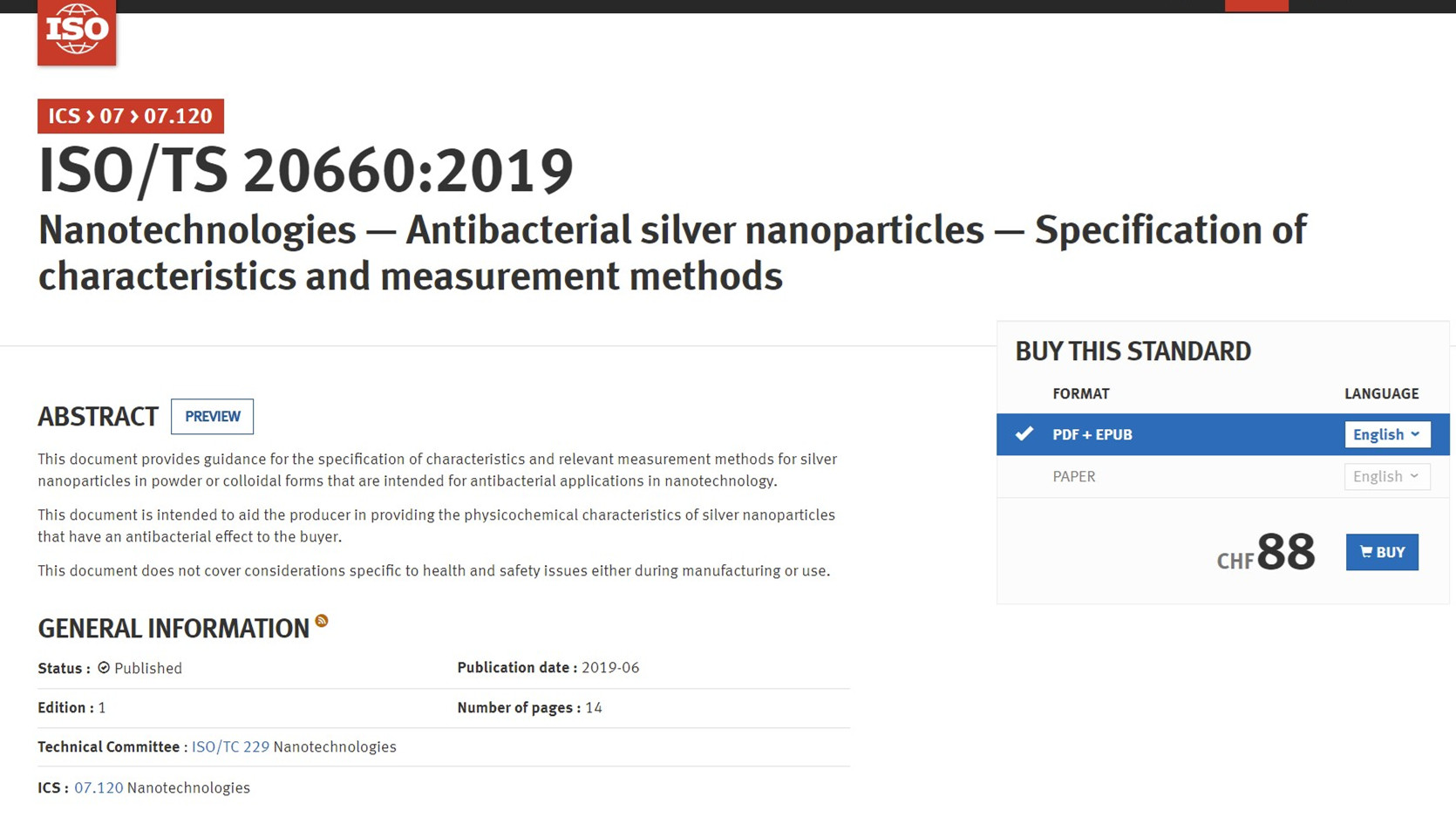纳米技术 抗菌银纳米粒子 特性和测量方法规范
时间:2022-03-07 16:10:34 来源:ISO 点击量:

ISO/TS 20660:2019
Nanotechnologies — Antibacterial silver nanoparticles — Specification of characteristics and measurement methods
Introduction
Silver nanoparticles have become one of the most widely utilized nanomaterials in consumer products for their antibacterial properties. The application of silver nanoparticles is increasingly being adopted in consumer products to control the growth of microorganisms on the surfaces or interiors of products. When silver nanoparticles interact with microorganisms silver ions are released, and these ions may affect and damage microorganisms in different ways. However, the mechanism behind the bactericidal effect is not well known[1]. There have been several possible mechanisms proposed in the scientific literature: 1) silver ions with positive electricity released from silver nanoparticles are able to rapidly bind to sulfhydryl groups on the surfaces of bacteria, which leads the structures of bacteria to change and become damaged, 2) the uptake of silver ions or small nanoparticles disrupts adenosine triphosphate production and DNA replication, and 3) silver nanoparticles and ions generate reactive oxygen species resulting in oxidative damage[2]-[4]. Other scientific evidence of the antibacterial performance of silver nanoparticle is listed in Annex B. The antibacterial properties of silver nanoparticles are related to their physicochemical characteristics.
Although antibacterial products that utilize silver nanoparticle are widely distributed in the market, most of these products are sold without providing information on the physicochemical and corresponding antibacterial characteristics of nanoparticles. Currently, most manufacturers provide specifications based on their own practices.
This document provides guidance for the specification of characteristics and relevant recommended measurement methods, referenced from other standards for silver nanoparticles in powder and colloidal forms that are intended for antibacterial applications in nanotechnology. The major measurement methods available to industry for the determination of parameters specified in this document are of course recommended in the specification. This document reviews selected measurement methods that are commonly used at present, and therefore will require updating on a regular basis.
1 Scope
This document provides guidance for the specification of characteristics and relevant measurement methods for silver nanoparticles in powder or colloidal forms that are intended for antibacterial applications in nanotechnology.
This document is intended to aid the producer in providing the physicochemical characteristics of silver nanoparticles that have an antibacterial effect to the buyer.
This document does not cover considerations specific to health and safety issues either during manufacturing or use.
2 Normative references
The following referenced documents are indispensable for the application of this document. For dated references, only the cited edition applies. For undated references, the latest edition of the referenced document (including any amendments) applies.
ISO 26824, Particle characterization of particulate systems — Vocabulary
ISO/TS 80004-1, Nanotechnologies — Vocabulary — Part 1: Core terms
ISO/TS 80004-2, Nanotechnologies — Vocabulary — Part 2: Nano-objects
3 Terms and definitions
For the purposes of this document, the terms and definitions given in ISO 26824, ISO/TS 80004-1, ISO/TS 80004-2 and the following apply.
ISO and IEC maintain terminological databases for use in standardization at the following addresses:
— ISO Online browsing platform: available at https://www.iso.org/obp
— IEC Electropedia: available at http://www.electropedia.org/
3.1
silver nanoparticle
nanoparticle composed of silver with all three external dimensions in the nanoscale
[SOURCE:modified from ISO/TS 80004-2, 4.1, modified]
3.2
primary particle
Original source particle (3.1) of agglomerates (3.4) or aggregates (3.5) or mixtures of the two
Note 1 to entry: Constituent particles (3.3) of agglomerates or aggregates at a certain actual state may be primary particles, but often the constituents are aggregates.
Note 2 to entry: Agglomerates and aggregates are also termed secondary particles.
[SOURCE:ISO 26824, 1.4]
3.3
nanoscale
size range from approximately 1 nm to 100 nm
Note 1 to entry: Properties that are not extrapolations from a larger size are predominantly exhibited in this length range.
[SOURCE:ISO/TS 80004-1, 2.1]
3.4
agglomerate
collection of weakly or medium strongly bound particles (3.1) where the resulting external surface area is similar to the sum of the surface areas of the individual components
Note 1 to entry: The forces holding agglomerate together are weak forces, for example van der Waals forces or simple physical entanglement.
Note 2 to entry: Agglomerates are also termed secondary particles and the original source particles are termed primary particles (3.2).
[SOURCE:ISO 26824, 1.2]
3.5
aggregate
particle (3.1) comprising strongly bonded or fused particles where the resulting external surface area is significantly smaller than the sum of surface areas of the individual components
Note 1 to entry: The forces holding an aggregate together are strong forces, for example covalent bonds, or those resulting from sintering or complex physical entanglement, or otherwise combined former primary particles.
Note 2 to entry: Aggregates are also termed secondary particles and the original source particles are termed primary particles (3.2).
[SOURCE:ISO 26824, 1.3]
3.6
antibacterial activity
property of substances or phenomena that kills (bactericidal) or slow down (bacteriostatic) the growth of bacteria
CIAA会员单位免费下载
